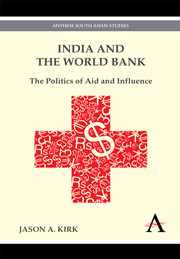Book contents
- Frontmatter
- Contents
- List of Illustrations
- Acknowledgements
- Introduction: Understanding the Bond between the World Bank and its Largest Borrower
- Chapter One The First Half-Century: From Bretton Woods to India's Liberalization Era
- Chapter Two Remaining Relevant: The World Bank's Strategy for an India of States
- Chapter Three Reasserting Central Government Control, Reorienting Aid toward “Lagging States”
- Chapter Four A Bittersweet “Graduation” from Aid: Can IDA Hold on to India, and Will India Let It?
- Chapter Five Commencement: India's Changing Relationship to Global Development Assistance
- Notes
- Bibliography
- Index
Chapter Three - Reasserting Central Government Control, Reorienting Aid toward “Lagging States”
Published online by Cambridge University Press: 05 March 2012
- Frontmatter
- Contents
- List of Illustrations
- Acknowledgements
- Introduction: Understanding the Bond between the World Bank and its Largest Borrower
- Chapter One The First Half-Century: From Bretton Woods to India's Liberalization Era
- Chapter Two Remaining Relevant: The World Bank's Strategy for an India of States
- Chapter Three Reasserting Central Government Control, Reorienting Aid toward “Lagging States”
- Chapter Four A Bittersweet “Graduation” from Aid: Can IDA Hold on to India, and Will India Let It?
- Chapter Five Commencement: India's Changing Relationship to Global Development Assistance
- Notes
- Bibliography
- Index
Summary
The concentration of World Bank programs in a few reforming states carried with it the predictable risks of portfolio concentration in a highly politicized context, which resulted in significant swings in the volume of lending and spending on analytical work. Especially during the early years of shift to state-level engagement, the residual role of the World Bank at the national level was not well-defined and dialogue with the center suffered.
World Bank, Country Strategy for IndiaM (2008b: Annex 4, p. 8).…a stage has come in our development where we should now, firstly, review our dependence on external donors. […] While being grateful to all our development partners of the past, I wish to announce that the Government of India would now prefer to provide relief…
The Honourable Jaswant Singh, Minister of Finance, Government of India, in his Budget Speech for 2003–4There could be multiple ‘equilibrium points’ in the Bank-India relationship […] Organizations learn from the frontier, from the field. The Bank can be flexible and opportunistic.
Dipak Dasgupta, Senior Economist, World Bank, New Delhi (2008)This chapter considers two broadly contemporaneous developments in India's aid policies during the early 2000s. The first was a clear effort by the Indian government to signal the country's diminished need for external assistance, crystallized in a 2003 announcement by Minister of Finance Jaswant Singh that India no longer wished to receive bilateral aid from 22 donor countries.
- Type
- Chapter
- Information
- India and the World BankThe Politics of Aid and Influence, pp. 97 - 136Publisher: Anthem PressPrint publication year: 2010



